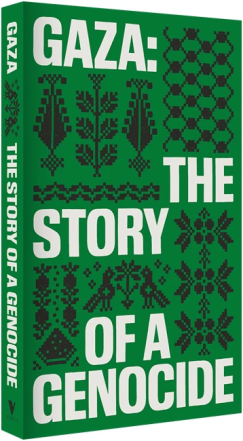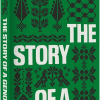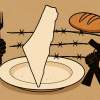
Gaza: The Story of a Genocide, edited by Fatima Bhutto and Sonia Faleiro. Verso, 2025
By Jon Baldwin
In a recent paper, Pre-Emptive/ Neo-Fascist Capitalism, Marxism and Resistance, Marxist educator Dave Hill has written that: “What Trump is doing is new but is also not new.” Trump is merely following the trajectory of the right, the classic response of fascism to the crisis of capital. Nothing inventive here. But what is novel is the blatantness and openness of the Trumpian operations of fascism. No attempt to even hide. Neo-Fascism in your face. Likewise the grim events in Gaza are not an aberration but the continuation of a project, now rendered blatant and transparent. Genocide in your face. The times are obscene.
Gaza: The Story of a Genocide is a necessary collection of contextualising journalism, reportage, art, poetry, testimony and autobiography that bears witness to the tragedy of Gaza. Blinne Ní Ghrálaigh, an adviser to the legal team of South Africa which brought the charge of genocide at the International Court of Justice, has said that Gaza represents “the first genocide in history where its victims are broadcasting their own destruction in real time, in desperate, so far vain, hope that the world might do something.” The ambition is that this book will compel (further) action, spur on a largely apathetic impotent international community, and all royalties will be donated directly to the United Nations Relief and Works Agency (UNRWA) for Palestine Refugees in the Near East. In a chapter in the volume, Why BDS – Boycott, Divestment and Sanctions – Matters, Omar Barghouti acknowledges that people of conscience around the world feel almost uncontainable rage, grief, and even fear, and are rightly shattered, and sometimes feel powerless: “Some have fallen despondent, complaining of genocide fatigue. But it is crucial to remember that Palestinians, especially in Gaza, do not have the luxury of genocide fatigue.”
In The Feeds of the IDF Depict What Zionism Can’t See, Mary Turfah contributes to the collection and confirms the notion of a live-streamed genocide. Footage from Israeli soldiers shows banal events like playing football, but also videos of atrocities such as “a soldier blowing up a residential block to celebrate his daughter’s birthday.” There is sharing and dissemination of graphic images of the dead or dying. What might be termed ‘settler psychosis’ or ‘complex trauma response’ to cyclical violence is apparent with sadistic snuff videos framed for social media and Twitterati. Turfah draws attention to the horrific account of a dead boy with cerebral palsy whose image was used on a mock-up film poster of Spielberg’s ‘E.T.’ with the film apparently entitled ‘A.H.M.E.T.’ The nine year old child’s actual name was Yazan. Concurrent with this is the Israeli rejection of such images, as well as rejection of images of dead bodies, grieving people, starving children. This is purportedly Palestinian propaganda and conspiracy to manipulate worldwide media and demonise Israel.
As recounted in the book, Gaza is now home to the largest cohort of child amputees in modern history. After two years of war in Ukraine the number of known child amputees was 30, in Gaza within two months it was over 1000 according to UNICEF. Gaza has seen 269 relief agents killed, the highest number of United Nations personnel lost in any conflict. Over 231 Palestinian journalists have been killed, double the annual global total of journalist fatalities. At the turn of the year there were an estimated 53,000 Palestinian fatalities but this figure omits those bodies still under rubble and unidentified, as well as the indirect fatalities of those who lacked access to medical care. The true figure, according to a report in the Lancet, is likely to be four times the official count. Amnesty International have declared the actions against Gaza as ‘genocidal’, with widescale destruction, mass displacement in unsafe and inhumane conditions, and restrictions on life-saving supplies and humanitarian aid. The attack on people, animals, infrastructure, education, the environment and so forth, is the attack on everything and anything that sustains life in Palestine. In Gaza, 70 percent of the population are refugees.
Joe Biden remarked back in 1986 that “were there not an Israel, the United States of America would have to invent an Israel to protect her interests in the region.” The contributors to this collection argue that the foreign policy and interests surrounding this ‘quasi-US outpost in the Middle East’ are entwined with forces of capitalism, imperialism, military occupation, systemic racism, apartheid, and settler colonisation. Mariam Barghouti, in On the Parallel Annexation of the West Bank, suggests that opposing Israeli policy does not equal antisemitism, that Judaism can be decoupled from Zionism, and there are anti-Netanyahu Israelis. She also details the everyday laborious labyrinth of identity cards, concrete barriers, checkpoints, military bases, open-air prisons and settlements. Attention is drawn to the power imbalance made grotesquely apparent after, as she puts it, “a small group of militants – raised in what amounts to an open-air prison – briefly ruptured Israel’s security apparatus.”
Behind these numbers and geopolitics are people. Poet and educator, Hiba Abu Nada, is published in the collection, I Grant You Refuge. Some lines read:
Grant them a death as beautiful as they are…
Our streets exalt God with every bomb….
I shield the oranges from the sting of phosphorous…
Aged 32, she was killed by an Israeli airstrike on 20th October, 2023. Also included is Ahmed Masoud’s poem, To Khalid – Killed on January 22, 2024, by an Israeli airstrike. An extract:
Just stay as we were
Two excited lads
Wanting to play the Oud
And cycle to the beach
I will practice playing new songs
Ahmed Alnaouq’s testimony, On Losing My Family – and My Mind, harrowingly opens with, “In the span of a single minute, twenty-one family members died, including my father, Nasri.”
Noor Alyacoubi, in On Searching for Food in Gaza, recalls the starvation forced on the people of Gaza: “It doesn’t matter if we find the flour infested with weevils; we’ll sift it, separating the insects…other alternatives also popped up, but they were mainly animal foods: corn and barley, smashed into soft flour. Their taste was beyond one’s ability to bear it, but it wasn’t a choice…We were forced to eat the green grass that grew by sidewalks or in empty fields…I now long for a fresh green apple.”
The awful dilemma facing ordinary people is set out in Unsafe Passage by Mosab Abu Toha: “We want to stay for our family, and we want to leave for our family.” Fleeing along a dusty road Toha encounters a group of donkeys and horses who are bleeding. “One horse’s tail is nearly detached. When a young man tries to quench its thirst, the water dribbles out of a hole in its neck. He asks me whether I have a knife, to put it out of its misery.” Later, encamped, Toha writes, “The soldiers give off a smell that reminds me of coffins. I find myself wishing that a heart attack would kill me.”
The volume includes two Joe Sacco graphic novel panels. Shareef Sarhan, in A Home for Art in Gaza, ponders, “How can one make art in the shadow of genocide? Yet, I must.” Ecocide in Palestine, by Nina Lakhani, informs that, “By the end of June 2024, approximately 83 percent of all plant life and 70 percent of farmland had been destroyed in Gaza, according to Forensic Architecture (FA).” In Uprising on a University Campus, Maryam Iqbal reveals one of a myriad of Western double standards and hypocrisy: “decolonisation theory is only acceptable at institutions like Columbia as long as it remains confined to the realm of theory.”
Eman Basher’s On Teaching in Gaza proclaims that “It was absurd, really, that the most fragile place could also be the strongest, but that’s Gaza for you – a place where hope is the ultimate act of defiance.” This hope might be strengthened by the BDS – Boycott, Divestment and Sanctions – movement. As Barghouti explains, “The BDS movement has adopted the historically proven method of targeted boycotts inspired by the South African anti-apartheid movement, the US civil rights movement, the Indian and Irish anti-colonial struggles, among others.” It categorically opposes all forms of racism, including Islamophobia, antisemitism, and anti-Palestinian racism and targets complicity, not identity. It targets institutions, not individuals. Tareq Baconi reminds that “The fate of Palestine is not only about Palestine, but about the global order and the struggle for a just world in which this topic is contested at an institutional level.” If Palestinian rights are the ‘litmus test for human rights’ then, as this crucial collection demands, there is much to do.













